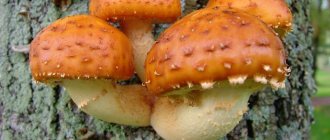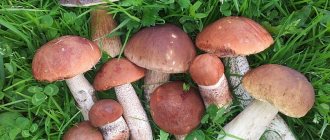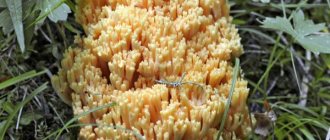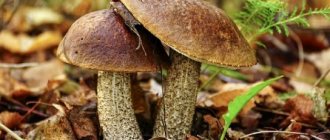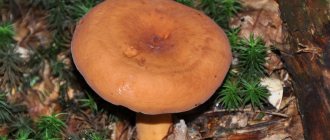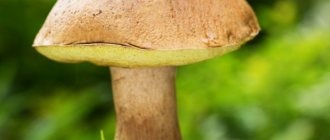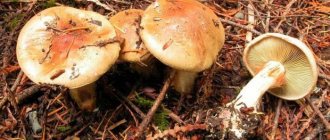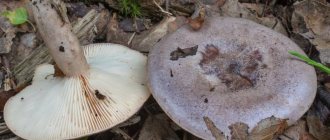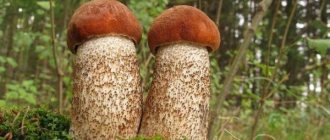In central Russia, in the forests you can find a huge number of peculiar mushrooms. However, both by its name and appearance, the satanic mushroom stands out from the general mass. However, even if you don’t yet know the name of this forest dweller, he will definitely attract your attention. Its appearance is different from other forest inhabitants, and its special smell will definitely prompt corresponding thoughts. How do you understand that you have encountered a satanic mushroom in the forest? How to distinguish it from other representatives of the forest? Is it actually poisonous or not? Is it useful for people or is it better to avoid it? We will definitely answer all these questions in this article.
Chemical composition, characteristics and brief description of the structure
The main danger of this fruiting body is that its appearance is very similar to an ordinary boletus. However, the Satanic mushroom belongs to the tubular mushroom, family Boletaceae (Boletaceae), genus Rubroboletus, species Rubroboletus satanas (Satanic mushroom). Latin names: Rubroboletus satanas, Boletus satanas. People also call it Satanic Bolet, Satanic Boletus.
Interesting to know! The satanic mushroom also received other names: forest devil, devil's mushroom, Satan.
Satanic mushroom
Such frightening, gloomy names are assigned to this representative of the forest kingdom only because it contains toxic substances - alkaloids, which in their effect are similar to the heavy toxin muscarine (part of the fly agaric). That is why this species is classified as not just conditionally edible, but poisonous mushrooms.
The cap is characterized by a hemispherical, cushion-shaped shape, its diameter is from 8 to 30 cm. In adulthood, it becomes more prostrate, smooth and velvety to the touch. Its color is closer to dirty gray, olive-grayish, sometimes an ocher, yellowish tint and greenish or yellow-pink stains appear.
The hymenophore (this is the lower part of the cap) of the forest devil is tubular. The tubes of a young mushroom are yellowish, later becoming greenish-yellow. The pores are small, initially yellow, with age they become orange, red, red-brown, and when pressed they turn blue-green.
The flesh is pale, almost white, slightly blue when cut. The mouths of the tubes are red. The aroma of the pulp in young specimens is weak and spicy, while in older specimens it is similar to the smell of carrion or rotten vegetables.
The structure of the leg is similar to the classic boletus: massive, barrel-shaped, tapering towards the cap. The height of this part can reach 6–15 cm, and the thickness from 3 to 10 cm. The color of the leg closer to the cap and at the base is yellowish; in the middle part it is red or orange-red, and has a barely noticeable mesh pattern.
A little history
Boletus satanas was first described by the German mycologist Harald Othmar Lenz in 1831. This scientist gave it this ominous name after he felt sick after eating the mushroom. Much later, in 2014, the satanic boletus was transferred to the new genus Rubroboletus, along with several other related reddish-red, blue-colored Bolete species.
Your Satanic Majesty
The Satanic Mushroom is a handsome man with a creepy name.
Why did this beautiful mushroom get such a scary name? It does not contain any terrible known poisons, it did not cause mass poisonings and extinction of the population, and it seems that it was not noticed in the bloody rituals of satanic cults. Obviously, the whole point is its solid beauty combined with pronounced inedibility. Imagine - in the middle of a lush green meadow there grows a battery of hefty, sprawling mushrooms with a bright red stem and a contrasting white cap. Beauty - and that’s all, but collecting and eating them is problematic - they taste bitter, and the gastric consequences can be very turbulent - nothing other than a temptation from the evil one... The main contribution to the spread of the frightening name was made by the German mycologist Harald Othmar Lenz, when in In 1831, he was poisoned by this mushroom, apparently after tasting it raw. He was the first to compile a detailed description of this species and attributed to it the name of the devil. Boletus Satanas is popularly called the Hellish, Devilish and Devil's mushroom.
Special signs
What does a satanic mushroom look like? If you cut the leg of a forest devil, the blue color will appear first, and then bright red. By this sign you can find out whether this species is poisonous or not. In addition, the flesh of the devil's mushroom has the smell of rotten onions or, according to some experts, may resemble the stench of carrion. Young specimens sometimes have no smell at all.
Note! If you cut the stem and it turns blue within 3-5 minutes, then this mushroom should be thrown away immediately, since in edible species the color of the flesh does not change when cut.
Where does it grow
You need to understand where the satanic mushroom is more likely to be found in order to be vigilant. It does not like cold, so it grows most often in the south of Europe, Primorye, Asia and the Caucasus. Even the Moscow or Kaluga region is already cold for it, so it can be found very rarely in these regions. The satanic disease grows from the end of June to the end of September.
The favorite soil of this mushroom is calcareous. They love places with good sunlight in a deciduous forest. This fungus is not found in coniferous plantings. The trees near which you can find the satanic boletus almost never grow wild in the middle zone:
- beech,
- hornbeam,
- oak,
- hazel,
- Linden;
- edible chestnut.
Edible or not?
In the specialized literature, this species is classified as conditionally edible. However, using satanic mushrooms for food without prolonged soaking and cooking for at least 10 hours is unacceptable. If you neglect these conditions, you can be seriously poisoned.
Despite the fact that biologists classify satanic mushrooms as conditionally edible, experts do not recommend risking your health and collecting them, since the amount of poison cannot be determined at home. Some sources contain evidence that this type of mushroom is definitely poisonous.
Difference between false doubles of poisonous mushroom
Many lovers of quiet hunting can often confuse this species with completely harmless conditionally edible or edible mushrooms. This is not surprising, because all representatives of Boletidae are very similar to each other. In addition, they may turn blue when cut when pressed.
For example, the white boletus (Boletus albidus) and the inedible boletus (Boletus calopus) are non-poisonous and are classified as conditionally edible, as they have a characteristic bitter taste. And the edible olive-brown boletus (Boletus luridus) and speckled boletus (Boletus erythropus) have a darker, brown cap. But it also happens the other way around, when boletus or poddubniks are mistaken for forest devils and are not put in the basket.
Beautiful boletus (Caloboletus calopus)
Boletus erythropus
How to distinguish from a subdubnik?
The main difference between the satanic mushroom and the completely harmless, tasty mushroom (Boletus erythropus) is the color of the cap. In the first it is white with a gray tint, and in the “Polish” (as the people call the poddubnik) it is always brown and dark. The cut flesh of an edible mushroom can also turn blue, but not as intensely as that of its poisonous counterpart.
How to distinguish from edible oak trees?
So, if there is a need to distinguish a satanic mushroom from an edible boletus mushroom, this can be done quite simply.
Firstly, edible mushrooms will never have a bright red stem or cap. This is the privilege of exclusively poisonous mushrooms. Therefore, if you see a red tint, then you know that you urgently need to avoid this mushroom.
Also, be very careful as this mushroom is likely to be toxic. In order to understand whether a mushroom is poisonous or not, you need to cut it exactly in half. Look at the pulp. If it is white and has a pleasant smell, then most likely the mushroom is edible. However, if the color is not natural, and the smell is not the most tasty and pleasant, this means that most likely you have found a mushroom that should under no circumstances be eaten.
This means that you are putting your health and the health of your loved ones at risk, so before cooking, check the contents of your basket again very carefully.
Toxicity, signs of poisoning and first aid
During satanic sickness poisoning, vomiting and indigestion occur, with the urge becoming more frequent and intense over time. In some cases, there is even paralysis of the limbs, fainting, and severe headaches. Death can occur from suffocation or cardiac arrest.
It is believed that the pulp of mushrooms, previously subjected to heat treatment, does not contain toxins, but it is better not to risk your health.
It is important to know! You can get poisoned by consuming even 1–2 grams of the fruiting bodies of the satanic boletus.
In case of intoxication, you should immediately call a doctor (ambulance) and induce vomiting in the patient by drinking a weak solution of potassium permanganate or mineral water with salt. It is very important at the initial stage to take a large amount of sorbents (activated, white carbon, enterosgel) in order to neutralize the effects of muscarine.
Difference from dubovik
Speckled Oak (Neoboletus erythropus)
These two species are surprisingly similar, sometimes so much so that even experienced silent hunters cannot tell the differences. But they still exist, and they are worth knowing so as not to harm your health. Similar features: both species can turn blue when the flesh is pressed, they are similar in appearance, and grow in approximately the same period.
Criteria by which you can determine a deadly poisonous species from oakweed:
- Pay attention to the reaction of the fruiting body when damaged. The dubovik immediately changes color and looks like a bruise. But the forest devil does not turn blue immediately, but after some time. At the same time, it first turns red, and only then acquires a characteristic blue color.
- Flesh color. The dubovik has a light yellow, almost lemon tint to this part, and the devil's mushroom is white.
- Hat color. In the edible species it is olive, sometimes orange, and in the poisonous species it is grey-green or grey.
In more detail, all the differences can be determined from the photo. There are many videos on the Internet from specialists and ordinary lovers of quiet hunting about the distinctive signs of satanic disease.
Advice from experienced mushroom pickers
When collecting edible oak mushrooms, mushroom pickers advise remembering several rules:
- If the species identity of a find is in doubt, it is better to avoid it and not take risks. The consequences of satanic mushroom poisoning are too serious to rely on luck when consuming mushroom pulp.
- When trying to find the differences between the oak mushroom and the poisonous satanic mushroom, it is best to rely on the change in color of the flesh when cut. Other differences may be less noticeable and not as clear-cut.
- Not all satanic mushrooms emit an unpleasant aroma of rotten onions. Young fruiting bodies can smell very pleasant, so smell also cannot be considered a sufficiently reliable difference.
In photographs, the oak mushroom and the satanic mushroom may appear completely different from each other. You should not be deceived by this, since differences in appearance strongly depend on growing conditions and even on lighting. In the forest, the differences often become less obvious, but the similarities become very strong.
Dangerous twins
Satan's boletus resembles other boletaceae with bluish flesh and colored spores. Among the inedible representatives, the devil's mushroom can be confused with the following species:
- The whitish boletus is not eaten because of its bitter taste;
- Boletus is pink-golden;
- Boletus inedible also has a bitter taste and is therefore inedible;
- Boletus le Gal or legal boletus;
- False satanic mushroom.
The latter type is called “false” for a reason, so it is worth dwelling in more detail on the differences between these two satanic mushrooms.
| Satanic mushroom | False satanic mushroom | |
| Name in Latin | boletus satanas | boletus splendidus |
| Toxicity | Poisonous | Conditionally edible |
| hat | Up to 30 cm, hemispherical or rounded-pillow-shaped, and then prostrate. The surface is smooth or slightly velvety, without moisture. | Dimensions: 5.5-10.5 cm, cushion-shaped, convex, with sharp and protruding edges. The surface is free of moisture, slightly felty or completely smooth. |
| Color | Most often whitish or grayish, but can be dirty gray or olive gray, with yellowish or ocher tinges and streaks | Milky coffee or brown with a pinkish tint |
| Pulp | White or yellowish in color, with moderate bluing or redness on the cut | Delicate consistency, light yellow in color, reddish or blue when cut |
| Leg | No more than 15 cm in length and up to approximately 9–10 cm thick, tuberous or barrel-shaped with a narrowing at the top, dense. The coloring at the top is yellowish-red, and at the base the color is brownish-yellow. The presence of a mesh cellular pattern. | No more than 8 cm with a diameter of 5 cm. Cylindrical in shape with a pronounced narrowing at the base. The surface is yellowish in color, with a carmine tint at the base, and covered with a thin mesh pattern. |
Reviews
When we go to the forest with friends, they give all the oak trees to me, because they are afraid of this mushroom. On the contrary, my wife and I adore them. Before boiling, I soak them in water for 10-15 minutes. I carry out this procedure three times. Then I boil it for 20 minutes, then wash it and boil it again for 15-20 minutes. As a result, it turns brown. It tastes great.
Lena.
I live in the Urals. We see Dubovik quite often. I don’t particularly respect them myself, as they turn very black during cooking. It ruins the appearance of soups and any other dishes I add them to. The taste is excellent, you can’t take that away from oak. When you cut the fruit body, it turns blue. This is a little scary, but it seems to be considered the norm. I have never seen Satanic mushrooms, so I can’t say whether they are similar or not, but judging by the photo they are almost identical.
Author: Olga · Published 10/11/2017 · Updated 10/15/2017
At the beginning of October, in the forest near the village of Toksovo in the Leningrad region, we found a strange mushroom. It captivated us with its noble appearance and intimidating crimson-red color, and also aroused interest and provoked controversy among experienced mushroom pickers.
Calling on the reference literature for help, the first version read:
" Satanic mushroom . Considered deadly poisonous. The cap is grayish or greenish in color, cushion-convex in shape, and becomes slimy in damp weather. The pulp is white, sweet in taste. (Did someone really manage to tell you before they left? =) When cut, the satanic mushroom turns red, then slowly changes color to blue. Leg with a red mesh pattern, tuberous-swollen at the base. The ground is a deep brick color and the top of the stalk is orange. Quite rare and found in the southern part of Russia, mainly in the Caucasus.”
Therefore, at first they decided that it was a satanic mushroom.
However, others noticed that they were collecting similar mushrooms in the mountains of Crimea. Local residents ate them and called them podduboviki. And they even shared a photo from their personal Crimean archive:
Mushrooms found in Crimea, which are eaten by local residents.
Therefore, continuing our search in the directory among edible mushrooms, we found the common oak mushroom, which is valued on a par with boletus mushrooms. It has the following description:
“ Common oakweed. The most striking sign is that it has a purplish-red tubular layer. The cap of a young mushroom is semicircular, later cushion-shaped, with a velvety surface to the touch. The color of the cap is yellowish-brown, dark brown or olive-brown. The stalk at the base is tuberous-thickened, whitish-yellowish, with a yellowish or reddish reticulate pattern. The pulp is strong, lemon-yellow in color, and quickly turns blue when cut. Without any special smell or taste. (You don’t have to worry about food)”
This description was more suitable to our find, the client was rehabilitated! Dubovik is sometimes mistakenly called Polish. When cut, our mushroom immediately began to turn blue, as can be seen in the photographs below.
This is the table we ended up with, which shows the differences between the satanic mushroom and the common oak mushroom :
| Characteristic | Satanic mushroom | Dubovik |
| Cap color | Grayish or greenish when wet - mucous. | Dark olive or yellowish-brown, slightly velvety. |
| Flesh color | White | Citric |
| At the breaking point | Turns red then slowly turns blue | Turns blue quickly |
But everyone was unanimous on one thing. This southern mushroom should not grow in the north. Therefore, the find was considered another sign of global warming, despite the very cool summer of 2021.
The forest where a strange mushroom was found.
Although most of those arguing agreed that this is an edible oak tree, no one dared to try it. Therefore, they unanimously decided to crush the mushroom into spores and scatter it in the nearest forest. Which is what they did.
We turn to experienced mushroom pickers. Is it really an oak mushroom or is it a satanic mushroom? And do they grow in the Leningrad region? Share your knowledge and experience.
The use of satanic mushroom in medicine
The beneficial properties of this fruiting body have long been used by shamans and witches, and at the moment various extracts and infusions from the satanic boletus are used in homeopathy. A small dose of the poison of this mushroom has a stimulating effect on the immune system and has a detrimental effect on the development of cancer. However, such properties have yet to be proven in official sources, so you should not take risks and self-medicate based on dubious, unconfirmed data.
Traditional medicine also uses satanic boletus to produce painkillers and tranquilizers. It also contains substances that have a paralyzing effect on the nervous system, which makes it possible to further develop drugs to relieve attacks of epilepsy, hysterical seizures, and can be used to treat neurological ailments.
It is important to know! Any self-medication with mushrooms or consumption of poisonous species (even in minimal dosage) can lead to serious poisoning or death!
Oak mushroom: description and ecology
Poddubovik is a large mushroom. The size of its cap reaches 20 cm, the length of the stem is 15 cm. The cap has a hemispherical or even convex shape. Its color is very variable: from the normal light olive-brown shade it often shifts to yellow, orange-yellow, or even red. The hat is sensitive to damage: you just need to put a little pressure on the oak, and the damaged area will soon turn blue, and then become black-brown, reminiscent of a bruise on a person’s skin after a bruise. It is from this property that the poddubnik received one of its names “bruise”. But this feature makes the color of its cap even less predictable: in some cases it may even turn out to be black-brown with red-yellow edges.
The leg of the undercloth has a barrel-shaped shape, later turning into cylindrical or club-shaped. The color is yellowish with a red “mesh”, at the base it turns into a wine-red shade or even black-brown. There may be reddish spots along the entire length of the leg, and greenish spots at the base.
The flesh of the mushroom is dense, without a distinct odor, and the cap is yellowish. The lower part of the leg is the same wine red as the leg itself in this place. When cut, it turns blue-green and then brown.
Podpodubnik grows in lowland deciduous and mixed forests. Often, as the name suggests, under oak trees, with which it enters into symbiosis (forms mycorrhizae). The collection season is July-September with a peak in August, but depending on the weather, oakberry can sometimes be found from May to November.
Interesting Facts
Some mushroom pickers claim that the satanic boletus can be called so because it can perfectly disguise itself as edible species (boletus, boletus, etc.), just as Satan changes his devilish appearance to the image of a pious one.
In France and the Czech Republic, the satanic mushroom is conditionally edible and allowed for consumption. It is considered a delicacy that can be prepared as usual. It is recommended to prepare soups, sauces, pickles and marinades from it.
Mikhail Vishnevsky, a well-known author of many books on mushrooms, states that “Boletus satanas has long been mistakenly considered poisonous. Currently, after boiling, this mushroom can be eaten without fear and used in various recipes.”
It has been noticed that worms eat all mushrooms, except poisonous ones. It is worth paying attention to the fact that in nature neither animals nor worms consume deadly plants. This information will help determine the edibility of mushrooms at the time of collection and allow them to be distinguished from other species.
Despite the polarity of opinions on the edibility of the satanic mushroom, it is worth always remembering that this species is extremely insidious. Even after prolonged and correct heat treatment, one cannot be completely sure that all toxins and poisons have been neutralized, and the fruiting body is absolutely safe for consumption. Don't risk your health, be extremely careful and selective during a quiet hunt!
Toxicity
However, the main danger of this mushroom is not only that it is poisonous. Satanic mushroom is truly toxic. This means that when using it, hallucinations and other visual and sound effects are possible. Some sounds become stronger, causing the person to go crazy and may even lose consciousness. And against the background of the resulting poisoning, this effect has the most unpleasant consequences. In medical practice, cases have been recorded where a person poisoned by a satanic mushroom experienced symptoms of poisoning for a very long time, then, having experienced the toxic effect, choked on vomiting. Therefore, the satanic mushroom is fraught with incredible dangers in terms of toxicity and toxic effect.
